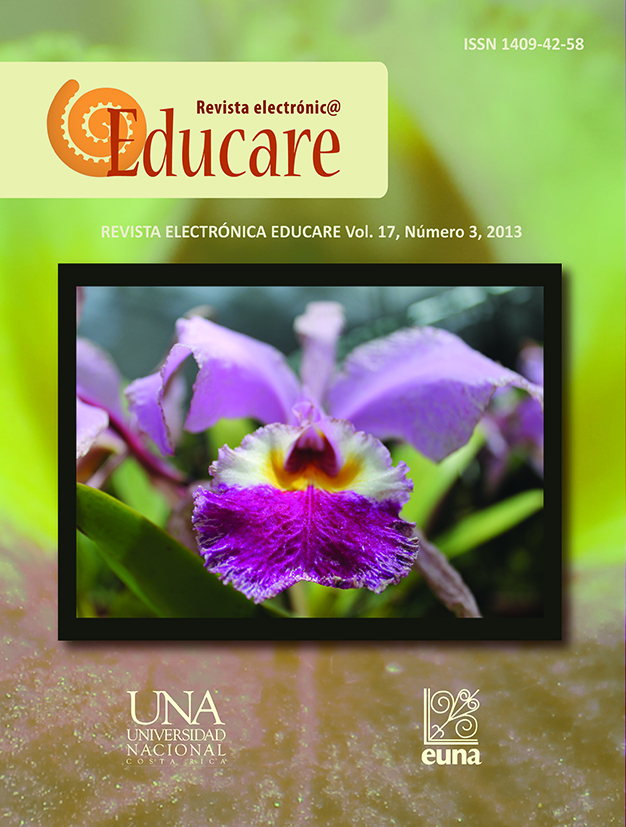ICT as a Technological Tool for the Development of Language Skills in Second Language University Students
DOI:
https://doi.org/10.15359/ree.17-3.13Keywords:
Information Communication Technology (ICT), language skills, language class, teaching strategies, technological tools.Abstract
This work aimed to make a research and collect information related to the use of ICTs by teachers of language at the School of Literature and Language Sciences (ELCL) of the Universidad Nacional (Costa Rica) and how they incorporate technological tools into the curriculum of their classes. It also provides some ideas on methodological strategies that can be used in the classroom with the use of ICT. To achieve the main objectives of this work, a questionnaire was used to conduct the research from a descriptive point of view, field work, through a qualitative approach. The interpretive/qualitative paradigm, also called phenomenological, naturalist, humanist or ethnographic, was used since it focuses on understanding and interpreting people`s reality, meanings and intention in order to build knowledge. The study takes place in a real context and a questionnaire was applied to 21 ELCL language teachers. The findings revealed that language teachers incorporate technological tools in a few activities in their classrooms; they do not take advantage of their applicability in all class activities. Besides, they really need more training to know, learn, and incorporate these tools in their curriculum, so they will develop an effective teaching and an active learning. This directed researchers to provide a list of recommendations about teaching techniques that will help language teachers improve their skills and incorporate these tools into their teaching strategies.
References
Cañarte, J. W. y Pibaque, M. (s. f.). El uso de las tic en el desarrollo de la expresión oral en el idioma inglés de la educación superior. Recuperado de http://www.monografias.com/trabajos83/doctora-ciencias-educacion/doctora-ciencias-educacion.shtml#top
Contreras, N. (2008). La enseñanza-aprendizaje de lenguas extranjeras y las TICs: El caso del español como Lengua Extranjera (ELE). Iniciación a la Investigación, Especial, i-vii Recuperado de http://revistaselectronicas.ujaen.es/index.php/ininv/article/view/233/214
Fernández, R. R., Server, P. M. y Carballo, C. E. (enero, 2006). Aprendizaje con nuevas tecnologías paradigma emergente. ¿Nuevas modalidades de aprendizaje? EDUTEC. Revista Electrónica de Tecnología Educativa, 20, 1-24. Recuperado de http://edutec.rediris.es/Revelec2/revelec20/raul20.pdf
Manga, A-M. (diciembre, 2008). Lengua Segunda (L2) Lengua Extranjera (LE): Factores e Incidencias de Enseñanza/Aprendizaje. Revista Electrónica de Estudios Filológicos, 16(16) Recuperado de http://www.um.es/tonosdigital/znum16/secciones/estudios--10-Ensenanza.htm
Morán, M. (18 de abril de 2012 ). Ventajas y desventajas del uso de las tic. [Mensaje en un blog]. Recuperado de http://excelenciaeneducacion.blogspot.com/2012/04/ventajas-y-desventajas-del-uso-de-las.html
Pérez, M. I. (2002). Apuntes metodológicos acerca de la enseñanza de lenguas asistida por ordenador (ELAO). GRETA Revista para profesores de inglés, 10(1), 55-61. Recuperado de http://www.freewebs.com/cfc03/apuntesmetodologicos.pdf
Richards, J. C. y Lockhart, Ch. (1998). Estrategias de reflexión sobre la enseñanza de idiomas. Cambridge University Press.
Salinas, J. (noviembre, 2004). Innovación docente y uso de las TIC en la enseñanza universitaria. Revista Universidad y Sociedad del Conocimiento, 1(1), 1-16. Recuperado de http://www.uoc.edu/rusc/dt/esp/salinas1104.pdf
UNESCO. (2004). Las Tecnologías de la información y comunicación en la formación docente: Guía de planificación (Trad. F. Trías y E. Ardans). Montevideo: Ediciones Trilce. Recuperado de http://unesdoc.unesco.org/images/0012/001295/129533s.pdf
Vélez, D. E, Vidal, M. y Yamá, D. (2010). Importancia de las TICS en la enseñanza de los idiomas: Beneficios [Diapositivas en PowerPoint]. Recuperado de http://es.scribd.com/doc/28772610/IMPORTANCIA-DE-LAS-TICS-EN-LA-ENSENANZA-DE
Downloads
Published
How to Cite
Issue
Section
License
1. In case the submitted paper is accepted for publication, the author(s) FREELY, COSTLESS, EXCLUSIVELY AND FOR AN INDEFINITE TERM transfer copyrights and patrimonial rights to Universidad Nacional (UNA, Costa Rica). For more details check the Originality Statement and Copyright Transfer Agreement
2. REUTILIZATION RIGHTS: UNA authorizes authors to use, for any purpose (among them selfarchiving or autoarchiving) and to publish in the Internet in any electronic site, the paper´'s final version, both approved and published (post print), as long as it is done with a non commercial purpose, does not generate derivates without previous consentment and recognizes both publisher's name and authorship.
3. The submission and possible publication of the paper in the Educare Electronic Journal is ruled by the Journal’s editorial policies, the institutional rules of Universidad Nacional and the laws of the Republic of Costa Rica. Additionally, any possible difference of opinion or future dispute shall be settled in accordance with the mechanisms of Alternative Dispute Resolution and the Costa Rican Jurisdiction.
4. In all cases, it is understood that the opinions issued are those of the authors and do not necessarily reflect the position and opinion of Educare, CIDE or Universidad Nacional, Costa Rica. It is also understood that, in the exercise of academic freedom, the authors have carried out a rogorous scientific-academic process of research, reflection and argumentation thar lays within the thematic scope of interest of the Journal.
5. The papers published by Educare Electronic Journal use a Creative Commons License:















 The articles published by Educare Electronic Journal can be shared with a Creative Commons License:
The articles published by Educare Electronic Journal can be shared with a Creative Commons License: 



